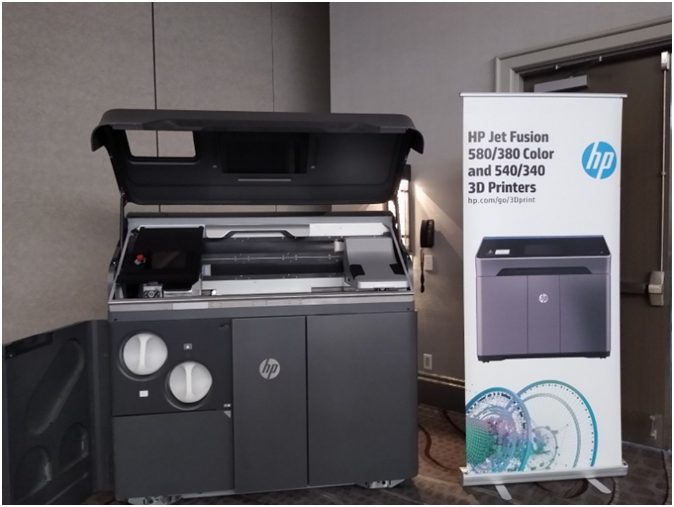![[Image: Preeti Sulibhavi]](https://fabbaloo.com/wp-content/uploads/2020/05/cimquest1_img_5eb08f713b607.png) [Image: Preeti Sulibhavi]
[Image: Preeti Sulibhavi]
Charles Goulding and Preeti Sulibhavi of R&D Tax Savers share their experience with HP 3D printing at the recent Cimquest Roadshow.
Cimquest Inc. is a leading resource for manufacturing solutions to a variety of companies. Part of its mission is to train and educate as well.
The HP Roadshow was held on September 26, 2019 in Melville, New York. The Roadshow is an excellent example of how Cimquest has remained focused on education and training.
A wide range of industries was represented at the event. From companies that 3D print kitchenware and paraphernalia to manufacturers of 3D printed orthopedic devices, the approximately forty attendees represented the highest caliber of design and manufacturing expertise on Long Island.
![HP 3D Scanner [Image: Preeti Sulibhavi]](https://fabbaloo.com/wp-content/uploads/2020/05/cimquest2_img_5eb08f719e47c.png) HP 3D Scanner [Image: Preeti Sulibhavi]
HP 3D Scanner [Image: Preeti Sulibhavi]
Cimquest has six locations in the United States and has working relationships with Formlabs, Desktop Metal, and Rize. Cimquest’s HP Roadshow was designed to focus on HP’s flagship 3D printer, the HP 4200 Jet Fusion series as well as the newer HP 5200 production 3D printer models.
The science behind 3D printers and 3D printing makes companies that invest heavily in the technology eligible for the R&D tax credit.
As part of the event, the authors were asked to present about the relevance of the R&D tax credit to 3D printers and technologies. The authors emphasized the tax savings and economic opportunities that can be derived from innovative activities such as 3D printing.
The Research & Development Tax Credit
![3D printed object scanned by the 3D scanner [Image: Preeti Sulibhavi]](https://fabbaloo.com/wp-content/uploads/2020/05/cimquest3_img_5eb08f72080c6.png) 3D printed object scanned by the 3D scanner [Image: Preeti Sulibhavi]
3D printed object scanned by the 3D scanner [Image: Preeti Sulibhavi]
U.S. Suppliers with 3D printing capability who design and manufacture new parts for these markets should be eligible for R&D tax credits.
Enacted in 1981, the now permanent Federal Research and Development (R&D) Tax Credit allows a credit that typically ranges from 4%-7% of eligible spending for new and improved products and processes. Qualified research must meet the following four criteria:
-
Must be technological in nature
-
Must be a component of the taxpayer’s business
-
Must represent R&D in the experimental sense and generally includes all such costs related to the development or improvement of a product or process
-
Must eliminate uncertainty through a process of experimentation that considers one or more alternatives
Eligible costs include US employee wages, cost of supplies consumed in the R&D process, cost of pre-production testing, US contract research expenses, and certain costs associated with developing a patent.
On December 18, 2015, President Obama signed the PATH Act, making the R&D Tax Credit permanent. Since 2016, the R&D credit has been used to offset Alternative Minimum Tax (AMT) for companies with revenue below $50MM and, startup businesses can obtain up to $250,000 per year in payroll tax cash rebates for up to five years.
HP, Inc.: #1 in PCs and Printers
![[Image: Preeti Sulibhavi]](https://fabbaloo.com/wp-content/uploads/2020/05/cimquest5_img_5eb08f727899a.png) [Image: Preeti Sulibhavi]
[Image: Preeti Sulibhavi]
HP has heralded 3D printing. For the past 15 years, HP has led the way for others to follow suit. Starting with their flagship product, the HP 4200 Jet Fusion technology 3D printer, HP has been moving from a prototype environment to a production one. The HP 4200 Jet Fusion series 3D printer was what brought HP into the 3D printing realm.
Today, HP 3D printers can create durable, yet lightweight, products. In addition, HP’s proprietary technology allows for a single part to have multiple textures and surfaces as well as a myriad of colors. This is a unique technical element and was illustrated at the Roadshow in Melville.
Conclusion
![David Macfie: Head of 3D Printer Sales at Cimquest [Image: Preeti Sulibhavi]](https://fabbaloo.com/wp-content/uploads/2020/05/cimquest4_img_5eb08f72cbe84.png) David Macfie: Head of 3D Printer Sales at Cimquest [Image: Preeti Sulibhavi]
David Macfie: Head of 3D Printer Sales at Cimquest [Image: Preeti Sulibhavi]
The Cimquest HP Roadshow was aimed at HP channel partner sales people and attendance counted as an equivalent to existing HP hardware sales certification. But the event offered much more than that. It created an opportunity to experience HP products and solutions in person and learn about the R&D tax credit incentive for innovation.

